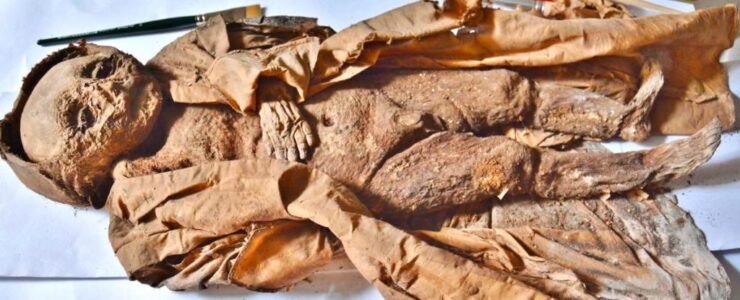Researchers identified a rare baby mummy as the firstborn son of an Austrian count, and rickets may have contributed to the child’s death.
A baby boy’s body was wrapped in a lovely silk coat, laid in an unmarked wooden coffin, and then his body was sealed in a family crypt in Austria some 400 years ago. The child’s body mummified here, shielded from the air outside.
Researchers investigating this corpse have now identified the unidentified little boy as Reichard Wilhelm, a member of Upper Austria’s affluent Starhemberg family. Additionally, they discovered that despite being well-fed, the youngster had rickets, a condition brought on by a deficiency in vitamin D, a substance that is present in some foods and that the body produces when it is exposed to sunshine. These findings were published on October 26 in the journal Frontiers in Medicine by the researchers.
“We have only one case and have to be cautious, but it may well have been that other infants also suffered from a similar lack of sunlight exposure and a vitamin deficiency,” says study leader Andreas Nerlich, a pathologist at Munich Clinic Bogenhausen in Germany.
Nerlich and his colleagues examined the baby mummy during restoration at the Counts of Starhemberg’s family crypt in Hellmonsödt, Austria, a village nine miles outside of Linz. According to the news of Scientific American, the family’s records date back to the 11th century, while the crypt was built around 1500 and expanded and renovated around 1600. Firstborn sons of the family, as well as their wives, were buried there.
Nerlich notes that the youngster, who was under two feet tall, was unusually well preserved. His left hand, which still had its fingernails, was resting on his belly as his torso was wrapped in a hooded garment. Due to the too-small coffin, his skull is slightly misshapen, and his lips is permanently pursed.
The researchers virtually autopsied the baby mummy using computed tomography after taking a small skin sample for radiocarbon dating. Their findings imply that the infant was well-fed, possibly obese, and had thick fat on his thighs and tummy. According to Michele Koons, curator of archaeology at the Denver Museum of Nature & Science, who was not involved in the research, this bodily fat may help to partially explain why he was mummified. Adipocere, a waxy material that can shield a body from decomposition, was produced when the fat and moisture reacted. The child’s teeth and bones indicate that he was between the ages of 10 and 18 months when he passed away.
The boy had rickets because his long bones’ ends were somewhat swollen and his ribs were covered in knobs. The expansion of cartilage in the joints is a result of this condition, which also weakens the bones. Lack of vitamin D, which the body needs to convert calcium and create healthy bones, is the basis of the issue. Given his abundant adipose tissue, the boy’s diet was undoubtedly high in calories, but the authors of the new study speculate that he may have still been deficient in important nutrients.
The boy may have also led a secluded life because the body can make vitamin D using energy from the sun. The authors hypothesized that he may have been shielded from the sun to maintain his pale skin, which was popular at the time among European nobility.
Whatever the cause, the child’s death might have been influenced by the rickets that followed. Rickets can predispose youngsters to pneumonia, which was evident in his lung tissue.
There are not many baby mummies from Europe, making young Reichard’s remains an unusual discovery. The kinds of information gleaned from adult and child mummies can be similar, said Bob Genheimer, curator of archaeology at the Cincinnati Museum Center (CMC), who was not involved in the study. The emotional aspects of studying a child can be different, however, he said: “Children are always the victims of premature death, and people seem to be much more protective of children”. CMC has a Roman-era Egyptian mummy of a child, nicknamed “Umi,” in its collections. Genheimer adds: “We gave our child mummy a name because none was listed on his cartonnage. We wanted to go that small step to restore some measure of humanity to him.”
